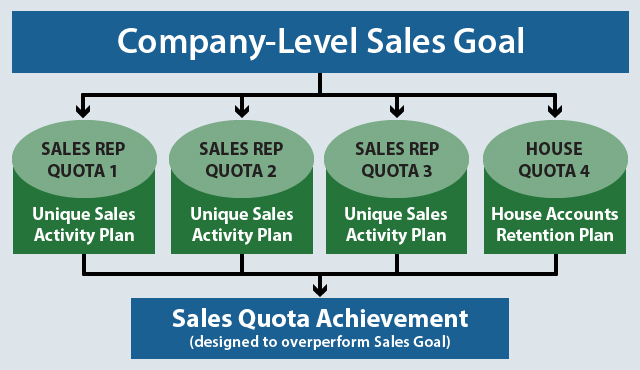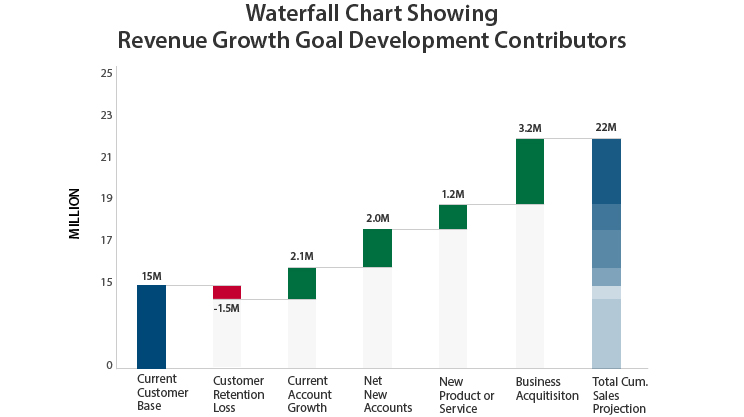Updated: December 2024
Whether your company has a single salesperson or a full sales team, translating your company-level sales goal into smart, attainable sales quotas notably increases your ability to achieve your goal. It also creates a path to scale your sales team as additional sales coverage is justified.
A recent survey revealed that only 28% of small and mid-sized businesses have individual sales quotas in place. This noteworthy statistic was derived by my Fractional Sales Leader peer group who has national exposure to thousands of client settings.
If you are amongst many businesses that are unknowingly limiting their growth trajectory by not assigning quotas to your sales contributors, learn how in this article.
Key Article Takeaways:
- How quota visibility increases collaboration amongst departments
- Why establishing sales objectives protects your overall business success
- How sales quotas provide a foundation for performance expectation levels
- How minimum targets stimulate focused training and coaching on high-value activities
The Benefits of Assigning Sales Quotas
Sales quotas, sometimes referred to as a sales objective or minimum target, are assigned to individual contributors who are responsible for generating revenue with a group of target accounts, a geographic region, or a vertical product category.
Designing and properly allocating quotas can provide the right motivation for your salespeople to reach their goals. This happens as sellers take personal accountability for the success of their sales activity plans, including the key milestones designed to track their progress.
Let’s keep in mind that the sales goal the company sets is also the revenue number the entire company’s budget is based upon. Differently, sales quotas are used to create clarity for salespeople to understand what is expected of them individually.
Therefore, the combined total of all sales quotas should exceed the number needed for the company to fulfill its budget. Intentionally inflating the company’s sales goals creates a buffer to account for missed quotas, ensuring the business’s budget remains unaffected.
The buffer also helps you handle unanticipated sales turnover, new competitive threats that hinder close rates, or any other unexpected sales disruptions each year.

This is a good time to note that when a company designates some of their mature customers as “House Accounts”, the assigned company representative should also have quota assignment and a plan to maximize revenue retention. This is especially true for high value accounts, no matter how locked in they may seem, to avoid undetected downward revenue trends.
Another benefit that comes from assigning quotas is creating sales credibility throughout the organization. When quota allocations are made visible to other departments, it provides understanding on how the sales team is driving to achieve the company-level sales goal that all employees are invested in achieving.
Sales transparency coupled with strong senior leadership fosters a natural increase in inter-departmental teamwork. This is critical in removing internal obstacles that otherwise may hinder projected sales growth.
Designing Sales Quotas that Sales Reps Embrace
Your salespeople need to view their quota assignment as a reasonable stretch. They need to accept accountability and have belief that they can build an activity plan to achieve the expectation.
Properly designed sales quotas need to be based upon a logic-driven, company-wide sales goal. If your revenue goal is not strategically configured, it is nearly impossible for cascading sales quotas to be achieved.
You should develop your strategic sales goal to be a target you can hit with effective planning and execution, not solely the target you desire.
For your sales goal to be calculated with purpose, you’ll want to add up all of the sales contributors that cumulatively make up your sales projection.
As shown in the Revenue Growth Contributors chart below, you’ll want to segment your contributing figures in alignment with how you plan to distribute them into individual sales quotas (i.e., by account groups, geographic region, vertical product category, etc.).

Given the importance of having a robust sales goal to build sales quotas upon, I wrote an article on this topic called, “Establishing Revenue Goals That Drive Growth and Success”.
Once you provide your salespeople with their sales quotas and contributors that justify the assignment, they are equipped to take ownership as they develop their sales activity plans.
A well-established plan will have elements for each revenue contributor, along with time allocation projections that reflect the amount of effort anticipated to deliver on the various targets.
It’s common for business leaders to avoid individual quotas because they think of their salespeople working as a unit, or because they only have one salesperson assigned to a particular division so they rely on that person for the entire company-level sales goal.
Without individual sales quota ownership, you are basing your sales goal success on hope and a whole lot of luck.
No matter the size or structure of a sales team, leveraging the strategies I outlined will put your growth plan on a much stronger platform for success.
Sales Management Tips to Drive Sales Achievement
Another area to consider is how you assign ramp-up sales quotas to new hires or a rep switching roles – both needing ample time to develop their sales pipeline before it’s reasonable to expect full-quota productivity.
Remember, quotas are most productive when a salesperson believes they are obtainable. This stimulates motivation to take ownership of the objective and the drive to achieve it.
Sales quotas provide the foundation for building an effective sales plan, but a well-designed compensation plan is what truly motivates salespeople to exceed their objectives.

You’ll want establish sales quota achievement as a key lever in your sales comp plan to incentive your salespeople to perform not only every year, but each and every day.
You’ll find ideas for how a sales quota can be leveraged to drive next level achievement in a previous article I wrote called, “How to Drive The Right Sales Behavior With Your Compensation Plan”.
This brings me to my final tips, which can make or break the effectiveness of sales quotas as true motivators: Frequency and Formality.
FREQUENCY– Sales quota assignment and its positioning as a lever in the salesperson’s compensation plan needs to be revisited every year. The configuration needs to align with the company’s evolving goals in order for sellers’ actions to be aligned with the way the rest of the organization is headed. Lack of unity will cause internal conflict and hinder your growth.
FORMALITY– It is essential that a seller’s quota and associated compensation plan is presented in writing and with comprehensive detail. Too often, I come across sellers who are not clear on how they are compensated or how close they are to achieving “next tier” performance that has significant impact to them and the organization. These are missed opportunities.
Securing a salesperson’s signature on a well-documented sales quota and compensation plan is essential to establishing a shared understanding of expectations. Annual recalibration ensures the company’s updated objectives are effectively cascaded into aligned targets for the sales team.
If you’d like to discuss a more strategic approach to setting your sales goals and how to translate them into sales quotas that are embraced by your salespeople, contact me at 321.229.8910 or smuniz@salesxceleration.com.
———————————————————————————–
I am part of a national group of Senior Sales Leaders who collaborate to share insights like the examples shown in this article. We formed because of our shared passion to help business leaders exponentially grow their revenue.

